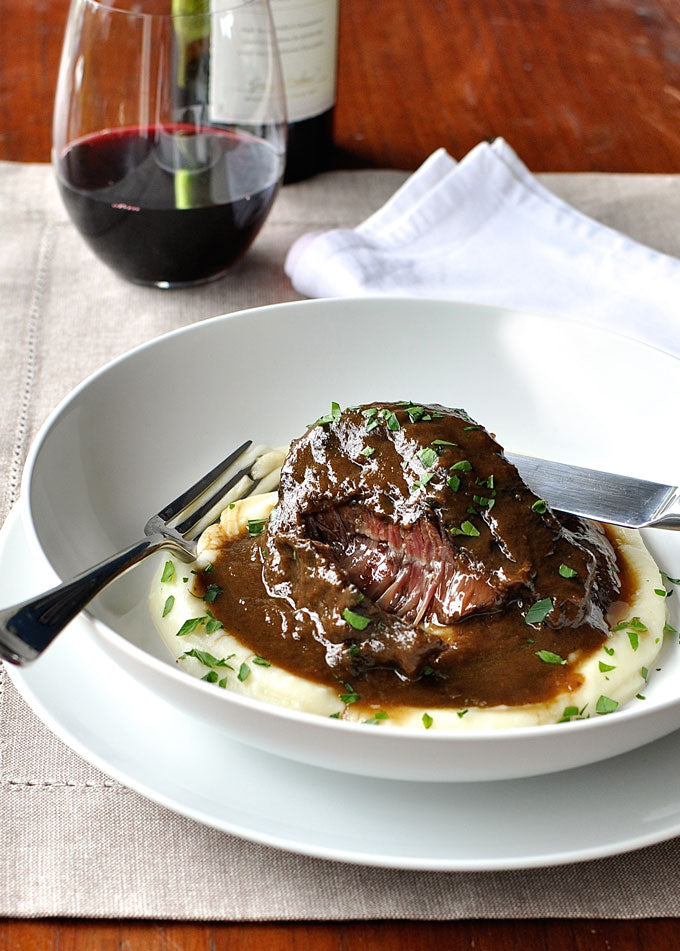Slow Cooked Beef Cheeks in Red Wine with Creamy Mashed Potatoes
These slow cooked beef cheeks are braised in a beautiful red wine sauce. They are so meltingly tender, you can eat it with a spoon. The braising liquid is infused with incredible flavour and when pureed, transforms into a thick, luscious gravy-like sauce.
Beef Cheeks are a budget cut of meat that are made for slow cooking. Perfectly accompanied with creamy mashed potatoes, this is a very easy dish that is suited to an elegant dinner party or a hearty midweek meal. Make this in your slow cooker or on the stove.
My Slow Cooked Beef Cheeks recipe is made with a classic Italian red wine braising liquid. The deep, warm, complex flavours of red wine are perfect for using as the stock base for slow cooked beef dishes. Go to your local liquor outlet and look for end of bin specials and pick up a bottle of a full bodied red wine like Merlot or Cabernet Sauvignon. You won’t use the whole bottle. If the wine is not to your standard for drinking, measure out cups and pour them into ziplock bags and freeze them. Handy to have when you need wine for other recipes.
Don’t let the length of the recipe directions fool you, this really is a simple recipe. It’s just long because I’ve provided directions for 3 different cooking methods and the mashed potatoes.
This Slow Cooked Beef Cheeks is a recipe that is elegant enough for a dinner party and if made using a slow cooker, easy enough for mid week. The other great thing about these Slow Cooked Beef Cheeks is that the leftovers can be used to make fast midweek meals and over the next couple of days I’ll be sharing two recipes – a Beef Ragu Pasta (a 15 minute meal) and a Beef, Mushroom and Vegetable Pie (15 minutes of prep). Don’t you love Cook-Once-Eat-Thrice recipes?? Use this weekend to make a triple batch of beef cheeks!
Prep Time
• Prep time: 15 minutes
• Cook time: 10 hours
• Yield: Serves 6
Ingredients
For Beef Cheeks:
• 3 tbsp olive oil , separated
• 1.5 kg/3lb beef cheeks , (4 large or 6 small beef cheeks)
• 1 onion (white, brown or yellow), roughly diced (about 1 cup)
• 1 celery stalk , roughly diced (about 1 cup)
• 1 carrot , roughly diced (about 3/4 cup)
• 4 garlic cloves , minced
• 6 stems of fresh thyme or 1 1/2 tsp dried thyme leaves
• 4 dried bay leaves (or 3 fresh bay leaves)
• 1 cup / 250 ml beef stock
• 2 cups / 500 ml red wine (full bodied eg. cabernet sauvignon or merlot)
• 2 - 3 tsp salt , separated
• Black pepper
For Creamy Mashed Potato:
• 800 g/1.6lb starchy potatoes (see notes), diced into 2cm / 3/4" cubes
• 2 tbsp butter
• 1 cup milk
• Salt and pepper
Method
- Prepare the beef cheeks: cut off any large, fatty membrane. Pat dry then use 1 tsp of salt and black pepper to season the beef all over.
- Heat 2 tbsp olive oil in a large heavy based pan (or casserole dish with a lid if you are baking or pot if you are cooking on the stove) over high heat. Sear the beef cheeks on each side until nicely browned. If your pan is not large enough, work in batches rather than crowding the pan. Remove beef cheeks onto a plate, loosely cover with foil to keep warm.
- Turn down the heat to medium high and heat the remaining 1 tbsp of olive oil. Add garlic, onion and carrots. Sauté for 3 minutes until onion is becoming translucent, then add the celery and sauté for a further 3 minutes.
- Follow directions for your chosen cooking method.
Different Cookers Methods
Slow Cooker Method:
- Pour the onion mixture into the slow cooker and place the beef cheeks on top.
- Pour the wine into the fry pan and return to heat. Turn the heat up to high, bring to simmer and let it simmer for 1 minute (to cook out the wine a bit). Scrape the brown bits off the bottom of the pan so it mixes in with the wine.
- Pour the wine into the slow cooker, then all the remaining ingredients, starting with a pinch of salt and pepper (add more to taste later).
- Cook in the slow cooker on Low for 8 hours or High for 6 hours for 250g/8oz size beef cheeks or Low for 10 - 12 hours or High for 8 hours for 350g/12oz beef cheeks.
- Open the slow cooker and remove the beef cheeks. Discard the thyme stems and bay leaves.
- Use a handheld stick blender to puree the braising liquid into a smooth Sauce - it will change from a dark brown to a lighter brown colour. If using a slow cooker without a sauté setting, pour the Sauce into a saucepan. If you have a sauté setting, leave it in the slow cooker.
- Put the saucepan over medium heat (or set the slow cooker to sauté setting) and bring to simmer.
- Simmer until the Sauce turns a darker brown colour and reduces by about 1/4 to 1/3, to a gravy consistency - about 10 minutes.
- Do a taste test and adjust the seasoning (salt and pepper) to your taste.
- Remove from heat, return beef cheeks to the Sauce, cover and keep warm until ready to serve.
Pressure Cooker Method: Follow the Slow Cooker directions but cook on high in your pressure cooker for 1 hour on high for small cheeks (around 250g/8oz each).
Stovetop and Oven Method:
- Pour the wine into the pot / casserole dish (with the onion mixture) and stir to scrape the brown bits off the bottom of the pot. Bring wine to simmer for 1 minute.
- Add remaining ingredients, starting with a pinch of salt and pepper (add more to taste later).
- Put lid on and cook on the stove on medium low for 2 to 2 1/2 hours or in the oven at 160C/320F for 3 to 3 1/2 hours until the cheeks are very tender. Turn at least once during cooking.
- Open the pot/casserole dish and remove the beef cheeks. Discard the thyme stems and bay leaves.
- Use a handheld stick blender to puree the braising liquid into a smooth Sauce - it will change from a dark brown to a lighter brown colour.
- Bring the Sauce to simmer over medium heat and simmer until it turns a darker brown colour and reduces by about 1/4 to 1/3, to a gravy consistency - about 3 to 5 minutes.
- Do a taste test and adjust the seasoning (salt and pepper) to your taste.
- Remove from heat, return beef cheeks to the Sauce, cover and keep warm until ready to serve.
Creamy Mashed Potatoes:
- Place potatoes in a large pot of salted boiling water and cook for 10 minutes until very soft.
- Turn the stove off, drain potatoes, then return to the pot.
- Add butter and milk and use a potato masher to mash until smooth.
- Add salt and pepper to taste. Use more milk to adjust the consistency to your liking. I like it fairly loose because it seems creamier (and less potato goes further).
To Serve: Serve beef cheeks on Creamy Mashed Potatoes, drizzled with a generous amount of Sauce. Garnish with finely chopped parsley if desired.
NOTES:
- Beef Cheeks aren’t always available in large supermarkets so you might have to go to the butcher. At my butcher, it’s a bit cheaper than other slow cooking cuts like chuck steak and brisket. If you can’t find Beef Cheeks, other slow cooking beef cuts will work fine. Cut them into 250g/8oz chunks so the same cooking times and liquid quantities in this recipe will apply.
- The beef cheeks I got were unusually large, around 350g/12oz each. Great man size portions. Usually beef cheeks are around 250g/8oz each and I get 6.
- If you can't find beef cheeks, substitute with any other cut of beef suitable for slow cooking. Cut them into 250g/8oz pieces.
- You need to use starchy potatoes for mashed potato as they breakdown when cooked, making them perfect for mashing. The best to use are Russet (common in the US), Yukon Gold, dutch creams, King Edwards or red delight. However, great all rounders like golden delight, coliban, red rascal and Sebago (popular in Australia) still works great.
- Leftover beef cheeks and sauce can be kept in the freezer for 3 months.
- Slow Cooked Beef Cheeks nutrition per serving, excluding mashed potato.
This great family recipe is thanks to RecipeTin Eats at https://www.recipetineats.com/slow-cooker-red-wine-beef-cheeks/



0 comments